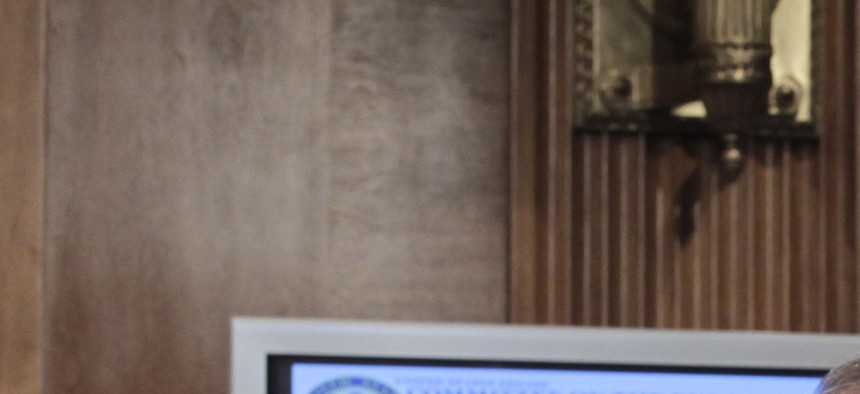
J. Scott Applewhite/AP file photo
Analysis: New Simpson-Bowles Plan Overstates the Deficit Problem
The country’s annual deficit is shrinking for now.
Deficit hawks Alan Simpson and Erskine Bowles just don’t quit.
The duo unveiled the latest iteration of their deficit-reduction plan on Tuesday, which calls for $2.4 trillion in cuts over 10 years — yet another chapter in their ongoing debt campaign that has not gained much political traction since 2010.
At first, Simpson and Bowles' newest proposal comes across as innovative: they learned from the past, rejiggered their suggestions, and rolled out a new framework during a quiet week when Congress was out-of-town. The new framework acknowledges the elusiveness of the big budget deal and instead lays out incremental spending cuts and tax increases that could occur over the next few years and into 2018. "Just the idea of a 'grand bargain' is at best on life support," said Erskine Bowles, the former chief-of-staff under President Bill Clinton, at a breakfast sponsored by Politico.
Such reasonableness attempts to cast the pair as aggressive, yet savvy deficit hawks who have taken a different, more nuanced tact that’s more in sync with the political reality of a very divided Congress and White House.
Yet, that’s not necessarily an accurate portrait of the current state of Simpson-Bowles. In fact, it appears to be doubling down on deficit-hawkishness just as the economy is improving and the deficit is shrinking.
The new plan calls for a 3:1 ratio of spending cuts to tax increases, whereas previous versions called for a more balanced ratio. That means that Simpson and Bowles are calling for the majority of future deficit reduction to come from spending cuts at a time when a wide swath of economists, including a prominent conservative economist from the American Enterprise Institute, have warned against sudden austerity measures.
Simpson-Bowles and like-minded hawks also uphold the belief that solving the deficit is the headline economic problem of 2013. Just check out the new website Debt Deniers, funded by Fix the Debt, a Simpson-Bowles sister organization run by the same web of alarmists.
The Debt Deniers site, unveiled late last week, calls out people “who claim America has no debt problem.” In ominous red, black, and white writing and graphics, the site criticizes “debt deniers” (cough, cough — like economist and New York Times’ columnist, Paul Krugman) who argue that the debt will solve itself, thanks to the slowly recovering economy, tax increases from the fiscal cliff deal, and spending caps set by the Budget Control Act of 2011. There’s nothing wrong with this strategy politically, except that it does not jibe with current economic data.
The deficit is not the primary economic problem of 2013; it’s just at the forefront of the political battles. (See: long-term unemployment, stagnant wages, or a slow-to-recover housing sector if you want to see real economic problems). Through the year 2016, the annual deficit is expected to shrink. (The Congressional Budget Office predicts it will decrease to $476 billion in 2016, compared to $845 billion in 2013).
Part of the reason the deficit is going down, at least temporarily, is that the federal government is taking in more revenue (25 percent more in the next two years). The rate of health care spending has slowed down considerably, and the economy is recovering, which means that Americans can pay more in taxes and/or rely less on the federal government for costly social safety net programs such as unemployment insurance or food stamps.
The deficit will start to significantly rise again by 2021 — though that’s a demographic and health care spending problem rather than an all-out crisis involving just too much debt. By then, the baby boomers will start to sign up en masse for Medicare, and no one from either end of the political spectrum has figured out a way to constrain health care costs given the large spike in people who will suddenly take advantage of federal benefits.
Arguably, that’s where Simpson and Bowles should expend their energy instead of talking about a deficit crisis that has yet to arrive on Washington’s doorstep, or by rejiggering a well-worn plan that’s made them wise, talking heads in Washington who still lack political juice.






